A deformed, tuberous, flattened bottom tomato with folds and dents is not only ugly. Such a vegetable can not be used for conservation and it is difficult to eat raw.There are several reasons why tomatoes grow clumsy and ugly. There may be the temperature at which they matured, a lack of light, diseases that affect plants in the nightshade family.
Content
Symptoms of uneven tomato formation
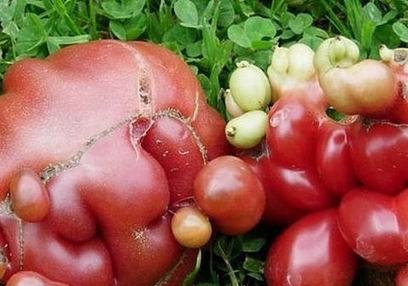 You can see that a tomato will grow deformed before it begins to ripen and long before its formation. You can identify changes in its development by several symptoms:
You can see that a tomato will grow deformed before it begins to ripen and long before its formation. You can identify changes in its development by several symptoms:
- Uneven tomatoes grow from fused and large flowers. During growth, the shoots and branches of the plant can begin to bend, and their stepsons will grow together.
- Tomatoes, which subsequently grow deformed, already at the very beginning of the formation are covered with deep furrows. These furrows can be seen or felt with your fingers, drawing along the skin of the vegetable at the point of attachment to the branch.
- Gnarled tomatoes grow on plants that are affected by rot.
To reduce the risk of ugly vegetables, it is necessary to remove fused inflorescences and stepsons and monitor the plants.
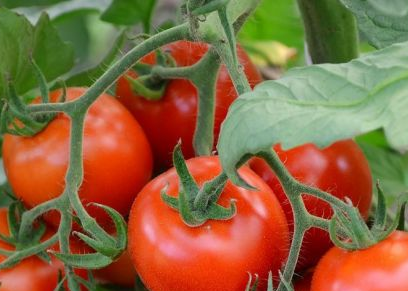 You may be interested in:
You may be interested in:Symptoms that should alert the gardener include the following:
- wilting of leaves at the bottom of the plant;
- the appearance of white plaque on the soil, leaves and stems;
- the formation of rot on the leaves and fruits.
All this suggests that the plant has few minerals, heat, light, or it suffers one of the diseases that affect nightshade.
Reasons for the formation of uneven fruits
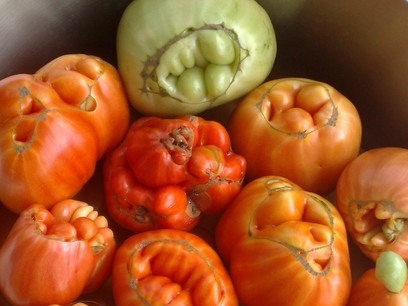 There are several reasons for the appearance of ugly tomatoes. Often such vegetables grow due to poor care associated with the inexperience of a gardener, less often due to a genetic mutation.
There are several reasons for the appearance of ugly tomatoes. Often such vegetables grow due to poor care associated with the inexperience of a gardener, less often due to a genetic mutation.
The main reasons for the formation of clumsy tomatoes include the following:
- lack of micro and macro elements in the soil;
- excess moisture in the soil;
- lack of light, heat;
- poor care;
- fascia;
- genetic mutation;
- a variety not suitable for the growing area;
- diseases.
A plant lacking micro and macro elements is not able to produce a good crop. On bushes that are poorly fed, small fruits grow interspersed with freaks. Due to the lack of potassium, calcium, phosphorus, iodine, copper, immunity of tomatoes suffers, so they become ill, give a bad crop or die.
Tomatoes love moisture, but its abundance harms them. Improper watering causes burns of the leaves of the plant or the formation of rot on them. Bushes of tomatoes are watered only in the morning when there is no sun. During the day, all the moisture has time to evaporate, and the rays of the sun will not burn the leaves on which there are drops of water.
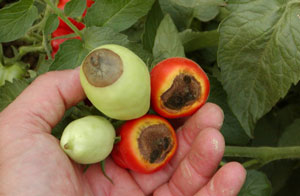 You may be interested in:
You may be interested in:Vegetables lacking light and heat do not develop well; the fruits grow on them small and uneven. You can avoid this by planning your landings. For beds under tomatoes it is worth choosing a shadowless place, and plant bushes so that each plant is evenly lit.
Tomatoes, seeds for which were taken from ugly, crooked fruits or hybrids, will grow the same. Non-zoned tomato varieties can produce ugly fruits.
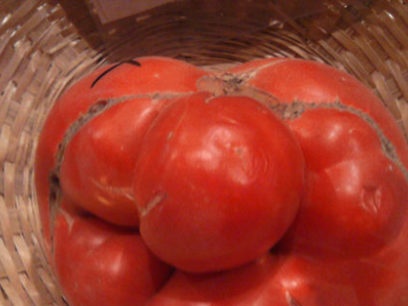 Tomatoes growing ugly are formed due to fasciation. This is a process of deformation in which deformation appears during the laying and formation of the fetus, as a result of which it grows together with a trunk, branch or neighboring fruit. Often ugly tomatoes emerge from a disproportionately large flower. Such a flower is called terry or royal, it appears on the bush the very first. Typically, such flowers are removed without waiting for the formation of the fetus.
Tomatoes growing ugly are formed due to fasciation. This is a process of deformation in which deformation appears during the laying and formation of the fetus, as a result of which it grows together with a trunk, branch or neighboring fruit. Often ugly tomatoes emerge from a disproportionately large flower. Such a flower is called terry or royal, it appears on the bush the very first. Typically, such flowers are removed without waiting for the formation of the fetus.
Poor care, as well as diseases that affect nightshade ones, also leads to the formation of tomato deformities.
If the tomato is deformed from below, its skin is unevenly colored, then most likely the reason for this is fungal or bacterial damage to the plant. Often, such fruits are also altered inside: the flesh may turn out to be loose or, conversely, hard and tasteless. Such tomatoes are not suitable for preservation and are not stored.
Treatment and nutrition of tomatoes
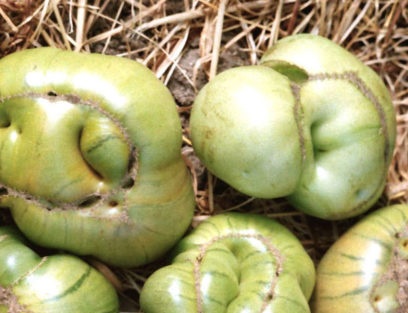 If the deformation of tomatoes was noticed in the early stages, then the bushes will urgently need to be fed. For this, a drug is suitable, in which there is no chemistry, but there are natural components: potassium and superphosphate. It will take 10 liters of water and one tablespoon of each substance.
If the deformation of tomatoes was noticed in the early stages, then the bushes will urgently need to be fed. For this, a drug is suitable, in which there is no chemistry, but there are natural components: potassium and superphosphate. It will take 10 liters of water and one tablespoon of each substance.
If the deformation is strong and it is formed due to poor soil, you can prepare a fertilizer, which will consist of the following components:
- Mullein or bird droppings - 20 grams;
- potassium sulfate - 25 grams;
- saltpeter - 15 grams.
All components must be mixed, infused for 4-6 hours and then added to water for watering the beds.
During treatment, tomatoes need not only fertilizing, but also compliance with the irrigation regime.
- If the tomatoes crack and are deformed at the same time, it is recommended to water them less often with less water (approximately twice).
- If a white coating appears on the soil, and the bushes become rotten, watering is also halved.
- If the fruit is deformed and grows slowly, and the leaves on the bush are curled and wilted, you need to water the tomatoes with plenty of water and preferably warm water.
- If one of the diseases became the cause of the deformation, it is necessary to treat the beds with a solution of potassium permanganate. Such a solution kills the fungus, but does not accumulate in the fruits.
- If the tomatoes are deformed due to excess moisture and lack of fertilizer, you can feed the bushes with ash (pour under the bush) or pour over the solution. To prepare the solution you will need water (half a bucket) and dry ash (a glass). The solution should be infused for two to three hours.
Bushes of tomato are watered under the root.
Prevention
After the tomato has formed, it is almost impossible to fix its ugliness. But you can prevent the appearance of such fruits. The preventive measures that prevent the appearance of clumsy tomatoes include the following:
- Seeding before planting or germinating.
- The choice of a hybrid or variety (they must be zoned).
- Compliance with the timing of landing.
- Regular top dressing.
One of the main reasons for the appearance of ugly tomatoes is their planting in the region that is not suitable for this hybrid or variety. If you plant a southern variety in the north, the tomato bush will lack heat and light, and its fruits will grow ugly. The same thing happens if you hurry up and plant the tomatoes ahead of schedule.
You should not take tomato seeds if in the past season strange bushes or flaws grew on their bushes.
It is not recommended to leave terry buds, since clumsy fruits appear from them. Also, such large buds reduce overall productivity.
Lack of pollination can also cause deformed tomatoes to appear. This is often faced by owners of sites located near major cities. In such areas there are few insects.
If tomato bushes grow in a greenhouse or in an area where there are almost no insects, pollination can be done by yourself. To do this, you just need a fluffy soft brush. To prevent the tomatoes from deforming, regularly feed the soil with mineral, nitrogen and organic fertilizers and treat the bushes from pests.
 You may be interested in:
You may be interested in:It is impossible to avoid the appearance of deformed tomatoes. Such fruits appear even among gardeners involved in the cultivation and cultivation of vegetables on an industrial scale. However, if you follow the general rules for growing, watering and feeding tomatoes, you can reduce their deformation.

 Low-growing tomatoes, without pinching: 5 of the most delicious varieties
Low-growing tomatoes, without pinching: 5 of the most delicious varieties Why tomato seedlings grow poorly
Why tomato seedlings grow poorly We grow a tomato in a shell
We grow a tomato in a shell Growing tomatoes without watering according to the method of Kazarin
Growing tomatoes without watering according to the method of Kazarin